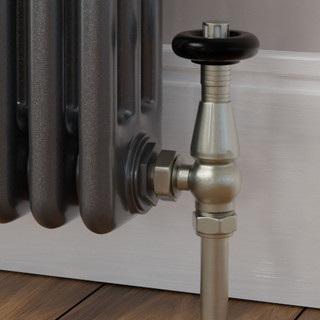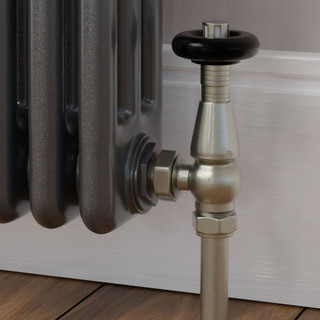Heated Towel Rail - A Buyer Guide
Posted by RW on 2nd Nov 2020
A Beginners Guide to Buying a Heated Towel Rail
There seems to be an endless selection of bathroom radiators, heated towel rails and towel warmers available to buy. So we have compiled a simple buyers guide to help you select the right heater and accessories for your bathroom.
Do I Need a Heated Towel Rail?
Well, you don’t really. However, when viewing a house potential buyers now expect all bathrooms to fitted with a towel rail, as they are now considered a standard fitting, rather than a luxury. Additionally, they are more practical than a radiator in a bathroom, for both heating the room and drying out towels.
What Types and Styles are Available?
Whilst there any many different designs of towel rail, these are categorised into three main styles. Ladder, designer and traditional. The simple ladder design is the most popular; as well as being the lowest cost, they are also simple to install and very practical. Designer bathroom radiators are more expensive by nature, but they can really offer the wow factor to a bathroom. As a company we started in the business more than 14 years ago, when we sold a huge amount of traditional towel rails, which hark back to the Victorian era. The older style often have ball jointed unions between the pipes and can be a simple design or include a cast iron or column radiator to offer more style and a great deal more heat output. Which ever style you choose, we have the towel rail for you.
Fuel Type
There are three main ways of heating your towel rail; a central heating system, a stand alone electric only unit or a dual fuel system, here is an explanation of each along with the pro’s and con’s.
Central Heating - this is still the most popular way of heating homes in the UK. If you have central heating in your home, connecting a towel radiator in your bathroom should be straight forward and a cost effective way to heat the room and dry your towels. The one downside to having a towel rail on your central heating circuit is that you won’t benefit from lovely warm towels in the summer months, when your central heating is not running.
Dual Fuel - you can add a dual fuel kit to many towel rail installations, this enables you to run the towel rail using your central heating during the winter months and then in the summer, you simply close off the inlet & lock-shield value (to avoid heating your whole system) and switch on the electric element. There are a number of elements that can be used, from simple on/off type to thermostatically controlled units. The element will need an isolating point, normally a fused spur, where an integrated timer can also be fitted for full control and energy efficiency. Dual fuel top-tip: Before shutting off your central heating valves, bleed the radiator to ensure it is full of fluid, this will avoid burning out the element if the radiator happened to be half empty. Also, once you have locked off your radiator valves, unscrew the lock-shield ¼ to ½ a turn, this allows for expansion and contraction of the water, as it heats and cools. Whilst very practical and offering year round comfort, the only real downside to dual fuel towel warmers that springs to mind is that the installation is probably less aesthetically pleasing than either central heating valves or an electric only unit.
Electric Only - from our personal experiences, electric only towel warmers are the way forward. Easy to install and offering year round warmth and cosy dry towels, they are what the majority of the team have installed in their family bathrooms and ensuites, along with electric underfloor heating to keep our toes warm. Whilst probably not as efficient as using your central heating system, you can use a timer to limit electric useage and we have neat control units that can adjust the heat output of a standard fixed element (for a lower temperature in the summer months), or as high tech thermostatic elements that offer additional functionality and features. Sometime In 2017 we also intend to launch an element that offers bluetooth control from mobile phone via an app.
Material
Towel rails are generally made from one or more of the following four metals, steel, stainless steel, brass or aluminium. Here is a brief overview of each.
Steel - probably the most common material for the simple reason it is the cheapest. The downside of steel is that it can rust, however, your central heating system should have additives to protect from corrosion and as long as the chrome finish or paint on the radiator is of a good quality, the steel should be protected from the moisture in your bathroom.
Stainless Steel - this material has no iron in it, so it can’t rust, which means it will last a long, long time. Another great advantage of stainless steel is that it radiates heat out into a room much more efficiently than a chrome plated steel radiator. If you compared two identical towel rails, one chrome plated steel and the other a polished stainless steel towel rail, the stainless steel one would radiate around 30% more heat into the room. This material can also be used on open circuits (not something you need to consider if you have conventional central heating), as stainless steel will not susceptible to the corrosive nature of the minerals in open circuit heating systems.
Brass - the very first original traditional style towel rails were made from copper, but this dented too easily, so brass was then employed as a better alternative. Brass being softer than steel polishes well, so you’ll often get the very best finish on a chrome plated brass towel rail, also popular for gold plated towel rails, so the same reason. Perfect for standard central heating and also suitable for open circuit systems, although stainless steel is probably the best option for open circuits these days. In conclusion, brass a high quality material, most commonly used in the manufacturing of traditional and bespoke heated towel rails.
Aluminium - a modern material for the production of radiators, it has design advantages that allow the manufacture of low water volume radiators (cheaper to run), as well as great heat outputs due to heat convection and expanded surface areas, created from extruded tube design that allow ridges and finns to be produced inside the tubes. If you are looking for an Eco-friendly towel rail, this is probably the first material to look at.
Finish
Chrome plated and polished stainless steel are the most popular finishes by far. Painted or powder-coated finishes used to be limited to white or cream, but in the past few years black and anthracite have become very popular and through certain suppliers we can now offer heated towel rails in just about any colour you want. If you don’t easily find a finish that suits your needs, just give us a call and we can advise you.
Accessories
As well as your towel rail, you will probably need some accessories; either a pair of radiator valves to connect it to the central heating system, a dual fuel kit, an electric only element or some form of control to operate these items. We have all of these available and can offer lots of advice, just pick up the phone and ask us. With more than 14 years experience and a bunch of knowledgeable, friendly staff, we are more than happy to help.
Customer Favourites:





















